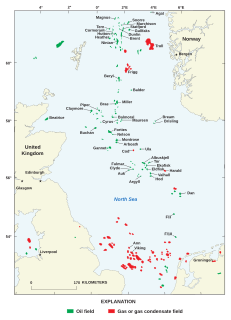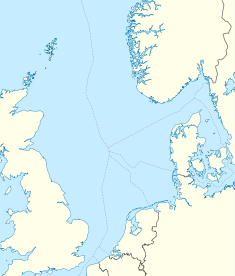
North Sea oil is a mixture of hydrocarbons, comprising liquid petroleum and natural gas, produced from petroleum reservoirs beneath the North Sea.

Ormen Lange is a natural gas field on the Norwegian continental shelf. It is situated 120 kilometres (75 mi) northwest of Kristiansund, where seabed depths vary between 800 and 1,100 metres. The field is named after the famous longship Ormen Lange of Olaf Tryggvason, a 10th-century Viking king of Norway.

A floating production storage and offloading (FPSO) unit is a floating vessel used by the offshore oil and gas industry for the production and processing of hydrocarbons, and for the storage of oil. An FPSO vessel is designed to receive hydrocarbons produced by itself or from nearby platforms or subsea template, process them, and store oil until it can be offloaded onto a tanker or, less frequently, transported through a pipeline. FPSOs are preferred in frontier offshore regions as they are easy to install, and do not require a local pipeline infrastructure to export oil. FPSOs can be a conversion of an oil tanker or can be a vessel built specially for the application. A vessel used only to store oil is referred to as a floating storage and offloading (FSO) vessel.

Ekofisk is an oil field in block 2/4 of the Norwegian sector of the North Sea about 320 km (200 mi) southwest of Stavanger. Discovered in 1969 by Phillips Petroleum Company, it remains one of the most important oil fields in the North Sea. This was the first discovery of oil after the drilling of over 200 exploration wells in the North Sea "triggered" by the Groningen gas field discovery. In 1971, Phillips started producing directly to tankers from four subsea wells. Oil production is planned to continue until at least 2050.
Oseberg is an offshore oil field with a gas cap in the North Sea located 140 km (87 mi) northwest of the city of Bergen on the southwestern coast of Norway. The field, which is 25 km long by 7 km wide, was discovered in 1979 and its development is known to be one of the significant milestones in emergence of Norway's independent oil and gas industry. The Oseberg field was named after Oseberg ship, one of Norway's most significant archeological discoveries. The ancient Viking ship from the early 9th century was discovered in a 1904 historical excavation of a burial mound at the Oseberg Farm, south of Oslo.

Valhall is an oil field in the Norwegian sector of the North Sea. Discovered in 1975, production began in 1982 and is expected to continue until 2050. Valhall is located in 70 metres of water. It produces from chalk in the Tor and Hod Formations of Late Cretaceous age. The reservoir depth is approximately 2 400 metres.
Norpipe is the undersea oil and natural gas pipelines system in the North Sea. It supplies oil from the Norwegian Ekofisk and associated fields in the North Sea to the United Kingdom and natural gas to Germany.

Draugen is an oil field in the Norwegian Sea with a sea depth of 250 metres (800 ft). It has been operating by A/S Norske Shell until sold to AS OKEA in 2018. The field has been developed with a concrete fixed facility and integrated topside. Stabilized oil is stored in tanks in the base of the facility. Two flowlines connect the facility to a floating loading buoy.
Yme is an oil field in the Egersund basin area in the central part of the North Sea. It is located 160 kilometres (99 mi) northeast of the Ekofisk oil field. The water depth is 93 metres (305 ft). The field was discovered in 1987 and was developed by Statoil with production from 1996 to 2001. In 2001 low oil prices led to the abandonment of the field. After the production license was relinquished by Statoil, a new license group led by Talisman Energy was formed to redevelop the field. In 2007 Talisman was granted permission to redevelop the field. The redevelopment was unsuccessful and the newly installed Yme MOPU STOR was abandoned and decommissioned without having entered production. A new attempt called the Yme New Development was launched by the new operator Repsol, which involved reusing the subsea installations already in place. The Yme field began producing again in 2021, marking the first time that a previously abandoned Norwegian oil field has been restarted.
Braathens Helikopter A/S was a Norwegian helicopter airline based at Stavanger Airport and Bergen Airport. It used a fleet of seven Aérospatiale Super Pumas to serve offshore oil platforms in the North Sea. The customers were Amoco, BP, Norsk Hydro, Phillips Petroleum and Statoil, serving their oil fields Ekofisk, Oseberg, Gullfaks, Veslefrikk, Valhall, Ula and Gyda. Braathens Helikopter operated from 1989 to 1993, after which it was sold to and merged with the main competitor, Helikopter Service. Braathens Helikopter was owned by Ludvig G. Braathens Rederi and was a sister company of the airline Braathens SAFE.

Grane is an offshore oil field in the North Sea located 185 km (115 mi) west of the city of Haugesund on the western coast of Norway. It is Norway's first heavy crude oil production field and Statoil's largest heavy oil field in the Norwegian continental shelf. The oil from the field, located in Block 25/11 is transported to Sture terminal via Grane oil pipeline. The injection gas is imported to Grane oil field from the Heimdal, located just north the field.
Oseberg Øst is an offshore oil field in the North Sea, located east of Oseberg Oil Field. The field was developed with a fixed production, drilling and quarters (PDQ) facility and is operated by Statoil. The first stage phase processing is done at the Oseberg Øst platform. The second and third phase processing of oil is done at the Oseberg Field Center and it is then transported to Sture terminal in Norway through the Oseberg Transport System.
Oseberg South is an offshore oil field in the North Sea, located 115 kilometres (71 mi) from the coastline and 13 kilometres (8.1 mi) south of Oseberg oil field. Oseberg Sør was discovered in 1984. The field was developed with a fixed production, drilling and quarters (PDQ) facility and is operated by Statoil. The first stage phase processing is done at the Oseberg Øst platform. The second and third phase processing of oil is done at the Oseberg Field Center and it is then transported to Sture Terminal in Norway through the Oseberg Transport System. The development of the Oseberg Sør was approved in 1977. Recent updates include approval of J structure which started producing in November 2006 and Oseberg Sør G Sentral which has been developed in 2009.
Skirne which also includes the Byggve deposit is an offshore gas field in the North Sea located 24 kilometres (15 mi) east of the Heimdal gas field and 140 kilometres (87 mi) from Stavanger, Norway. The depth of the water in the field area is 120 metres (390 ft). Both Skirne and Byggve are considered satellites to Heimdal field and are connected to it by subsea pipelines. TotalFinaElf which is the operator had received the approval from Norwegian Ministry of Petroleum and Energy for development of the fields in 2002. The company holds 40% interest in the project. Other stakeholders are Petoro and Centrica. Both Skirne and Byggve have an estimated 230 billion cubic feet of natural gas and about 10 million barrels of condensate, combined.
Brage is an offshore oil field in the North Sea located 120 km (75 mi) northwest of the city of Bergen on the western coast of Norway and 13 km (8.1 mi) east of Oseberg Field Center. The field also contains gas. The water depth at the location is 140 metres (460 ft). The field was developed with a fixed integrated production, drilling and accommodation facility The oil from the field is pumped through a pipeline to Oseberg A facility from where it is transported to Sture terminal via Oseberg Transport System. The gas from the field is exported through Statpipe system to Kårstø. It is estimated that Brage may hold up to 20,000,000 barrels (3,200,000 m3) to 25,000,000 barrels (4,000,000 m3) of recoverable oil.
Ula is an offshore oil field located in the southern Norwegian section of North Sea along with Gyda, Tambar and Tambar East fields making up the UGT area, usually attributed to DONG Energy's main areas of exploration and production activity.
Oselvar is a since April 2018 abandoned subsea oil field located 250 km (160 mi) southwest of Stavanger in the southern Norwegian section of the North Sea, close to the British border. Oselvar was discovered in 1991. The field is located at 23 kilometres (14 mi) distance from the Ula field to which it was tied back. The original estimated reserves at Oselvar were 38 million barrels of oil and 4 billion cubic metres of natural gas. The water depth at location is 72 metres (236 ft). The Oselvar field installations shall be decommissioned by the end of 2022.
Gyda is an offshore oil field located in the southern Norwegian section of North Sea along with Ula, Tambar and Tambar East fields making up the UGT area, usually attributed to DONG Energy's main areas of exploration and production activity. The Gyda field was discovered in 1980 and started producing on June 21, 1990. The field contains confirmed 39.6 million m3 of oil and 6.6 billion cubic meter of natural gas.
Blane is an offshore oil field located in the southern Norwegian and northern British sectors of North Sea. The Blane facilities are located on the British continental shelf and are tied to the Ula field which is located 34 km (21 mi) to the northeast via subsea pipeline. The field was discovered in 1989 and produces high quality oil.








